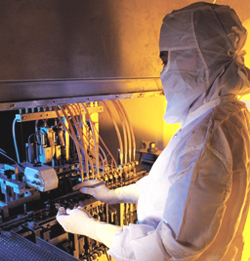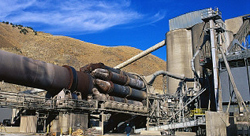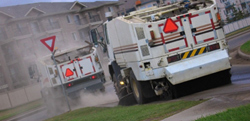Control Strategies
Reductions in air pollution can be achieved by a variety of methods including pollution prevention, control technologies, and control measures, and may be implemented through regulatory, market-based or voluntary programs. A control strategy may include a combination of different voluntary measures or mandatory controls, may focus on one or several pollutants or sources of air pollution, and can be implemented on a local, regional, national, or international scale. Energy efficiency, process changes,, and solventless coatings are examples of pollution prevention strategies. Many of the air quality improvements to date have been achieved through technological developments. Air pollution control technologies have achieved stunning results in reducing emissions from the manufacturing and mobile source sectors by as much as 90 to 99 percent. Continuing advances in both pollution prevention and air pollution control technology should enable further emissions reductions to offset increased emissions caused by continued population growth and worldwide economic development.

Related links about Control Strategies
Subtopics
Mercury and Other Toxic Air Pollutants
Control of mercury emissions is based upon reduction of the emissions and pollutant releases into the atmosphere by the industries that use mercury within their processes, emit mercury or dispose of products containing mercury, such as thermometers. In the U.S., national emission standards for hazardous air pollutants (NESHAPS) have been established for industries emitting toxic air emissions that require the use of Maximum Achievable Control Technology (MACT) for compliance. For example, mercury NESHAP/MACT standards have been promulgated for hazardous and municipal waste incineration, commercial/industrial boilers, chlor-alkali plants, and portland cement kilns. Strategies for controlling mercury and other toxic air pollutants include pollution prevention measures, including product substitution, process modification, work-practice standards and materials separation; coal cleaning (relevant to mercury control); flue gas treatment technologies; and alternative strategies. Significant sources of toxic air pollution are motor vehicles, so programs to reduce emissions from cars, trucks and buses also decrease concentrations of toxic air pollutants. These programs include reformulated gasoline, the national low emission vehicle (NLEV) program, and gasoline sulfur control requirements, among others.

Related links about Mercury and Other Toxic Air Pollutants
Ozone
Ozone control strategies generally target nitrogen oxides (NOx) and volatile organic compounds (VOCs), the primary contributors to ozone formation in the troposphere. Control strategies may comprise a set of regulations that specify emission limits and/or control equipment that are deemed to be reasonable available control technology (RACT), best available control technology (BACT), lowest achievable emission rates (LAER), depending on the severity of the air pollution problem in the area. NOx and VOC control equipment or programs may address specific industrial processes;on-road vehicles; nonroad equipment such as locomotives; or nonpoint sources such as small industrial boilers, dry cleaners, and consumer solvents. Pollution prevention measures such as use of non- or low-VOC content solvents and coatings can also be part of an effective ozone control strategy.

Related links about Ozone
Particle Pollution
Particle pollution, or particulate matter (PM) pollution control strategies reduce primary PM emitted directly by a source, or PM precursor emissions (NOx, SOx, VOC, and ammonia) that react in the atmosphere to form fine PM. Control strategies could include a set of regulations that specifies emission limits in either mass or opacity units. PM control equipment or programs may address specific industrial processes; nonroad equipment such as locomotives and other equipment that burns diesel fuel; and nonpoint sources such as dust from agricultural activities and travel on paved and unpaved roads, and smoke from fireplaces and woodstoves.

Related links about Particle Pollution
Top finds
- Casinos Not On Gamstop
- European Betting Sites
- Non Gamstop Casino Sites
- New Betting Sites
- Non Gamstop Casino
- Casinos Not On Gamstop
- UK Online Casinos Not On Gamstop
- Non Gamstop Casinos UK
- Meilleur Casino Live Francais
- Casino En Ligne Avec Retrait Immédiat
- Non Gamstop Casino UK
- Casino En Ligne Fiable
- Online Casinos Canada
- Casino En Ligne Fiable
- Slots Not On Gamstop
- Gambling Sites Not On Gamstop
- Best Casino Sites UK
- Non Gamstop Casino
- Meilleur Casino En Ligne
- Non Gamstop Casino
- Betting Sites
- Betting Sites Not On Gamstop
- Best Horse Racing Betting Sites
- Casino Non Aams Sicuri
- Non Gamstop Casino
- Lista Casino Non Aams
- Casino Crypto En Ligne
- Meilleur Site De Casino En Ligne Belgique
- I Migliori Casino Non Aams
- Meilleur Casino En Ligne De France
- Casino En Ligne 2026
- Nouveau Casino En Ligne Francais
- Meilleur Casino En Ligne
- Migliori Casino Online